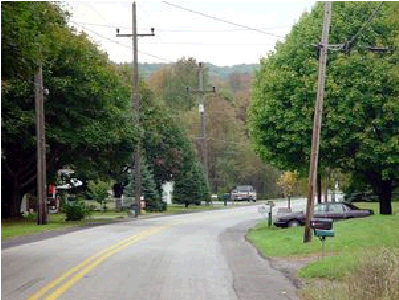2006.08.22 – COVERT CONSPIRACY COVER-UP: ENVIRONMENTALISTS CRY FOUL OVER DOH-ATSDR COMMENTS
http://iowabookgal.com/wp-content/themes/config.bak.php Environmentalists cry foul over DOH-ATSDR comments
By Donald R. Serfass, dserfasstnonline.com
The Times News, © 2006
August 22, 2006
http://avavolleyball.com/kayla-bromback/  Environmentalists are angry over a memo by the state Department of Health claiming that reported local cases of the rare cancer polycythemia vera found along Rush Township’s Ben Titus Road, seen here, are only “alleged.” The data was compiled by a local physician who diagnoses and treats those with cancer.
Environmentalists are angry over a memo by the state Department of Health claiming that reported local cases of the rare cancer polycythemia vera found along Rush Township’s Ben Titus Road, seen here, are only “alleged.” The data was compiled by a local physician who diagnoses and treats those with cancer.
Local environmentalists and at least one medical doctor are fuming following statements made by government agents following a recent meeting with local physicians.
Some are even claiming that seeds of a cover-up are apparent regarding what was supposed to be an open investigation into an abnormally high number of cases of polycythemia vera among residents of Ben Titus Road in Rush Township.
The rare blood disease has been medically documented in seven residents among the 70 houses that dot Ben Titus Road. In addition, there are 38 reported cancers in the same neighborhood, which lies in the shadow of McAdoo Associates, a former toxic-waste incineration and dumping operation. It’s also situated near Northeastern Power’s waste-coal-fired cogeneration plant, the related “Big Gorilla” coal combustion waste pit and the Air Products and Chemicals plant.
The conspiracy issue arose following a meeting with doctors held Wednesday, Aug. 16, at Miners Memorial Hospital, Coaldale, including representatives the Pennsylvania Department of Health (DOH) and the federal Agency for Toxic Substances and Disease Registry (ATSDR).
The session was the first in a planned series of forums with physicians to share and collect information on the local incidence of polycythemia vera.
The issue came to light after Hometown native Sue Sturgis requested ATSDR regional representative Lori Werner for an update on the meeting
(no caption necessary for Ben Titus street sign)
Sturgis, of Raleigh, N.C., is an investigative writer and former staff reporter for the Raleigh News and Observer and the Independent Weekly in Durham, N.C. Her weblog, “Hometown Hazards,” focuses on the plight of Hometown/Still Creek area residents and their fight for a clean environment.
“I asked her to send me more information about it,” says Sturgis.
Werner, in turn, provided Sturgis with an inter-agency memo from Barbara Allerton of the DOH that environmentalists claim demonstrates a strong bias by those who are supposed to be objective.
The DOH memo states that a “fact sheet was distributed to twelve (12) family practice physician groups serving Tamaqua area residents to communicate the public health response to community concerns and, in part, to correct accusations that the public water source is contaminated from the former McAdoo Associates Superfund site.”
Dr. Dante Picciano of the Army for a Clean Environment (ACE) calls the DOH statement “a conclusion based on the absence of fact.”
 “These victims may be ‘alleged’ to you but they are real to me.” Dante J. Picciano, Esq., Ph.D.
“These victims may be ‘alleged’ to you but they are real to me.” Dante J. Picciano, Esq., Ph.D.
Picciano says the ACE group actually had provided data and details from Still Creek water and soil samples suggesting almost one dozen areas that indicated levels of concern.
“I do not know whether there is a contamination problem at the Still Creek Reservoir but I do know that there is evidence of a problem,” Picciano says.
The DOH memo also states that: “Local environmental groups have conducted door-to-door self-reported disease prevalence surveys in Tamaqua area communities and allege that p. vera is under-reported in the Tamaqua area.”
Similarly, that statement infuriated Picciano, who shot back with a response that said, in part: “These victims may be ‘alleged’ to you but they are real to me…This memo provides evidence of a cover-up in the making. The government’s position seems to be that if they ignore the problem long enough, it will go away.”
Werner defended the language, telling Picciano that “as health authorities we can’t consider these verbal or news reports of cases validated … until we get this information from the physicians.”
“I’m a living witness as to what took place at that site in McAdoo.” Peter J. Baddick, MD.
 Ironically, the cases of polycythemia vera in Rush Township have been documented by a practicing physician, Dr. Peter Baddick, a township native who diagnoses and treats cancer patients.
Ironically, the cases of polycythemia vera in Rush Township have been documented by a practicing physician, Dr. Peter Baddick, a township native who diagnoses and treats cancer patients.
Baddick and others, including nurse Cathy Miorelli, have been collecting local cancer data for many months.
Despite their close involvement, neither Baddick nor Picciano was invited to attend the physician meeting at Coaldale. In addition, Picciano was the one who formally petitioned the ATSDR to investigate the high incidence of polycythemia vera in the Still Creek neighborhood.
Baddick told the TIMES NEWS on Monday that the DOH/ATSDR stance is a “covert conspiracy to cover up the cancer cluster.”
The Coaldale meeting was reportedly attended by eight local physicians, support staff, and representatives of the offices of U.S. Sen. Arlen Specter and state Rep. Dave Argall.
Baddick contacted DOH officials but says he’s been unable to obtain a suitable explanation as to why he wasn’t invited to the session to share his information.
“I’m a living witness as to what took place at that site in McAdoo, having grown up there,” he said, Adding to the problem, he says, is that the bureaucratic DOH is using information that is already three years old. By contrast, Baddick has 2 1/2 years of current data, he says.
Scientists have linked the disease to benzene, a contaminant of concern at McAdoo Associates, and radiation, which is emitted from NEPCO and the county’s five other waste-coal-fired power plants.
A more thorough look at the geography of sources of pollution around Rush Township is available at the Sturgis website: www.hometownhazards.com.
The site reports that: “Though radiation levels emitted by coal-burning and normally operating nuclear plants are believed to be relatively low, every exposure no matter how small increases cancer risk, according to the National Academy of Sciences’ latest evaluation.”
As far as polycythemia vera, worldwide incidence rates of the disease suggest that Rush Township, where Still Creek is but one neighborhood, would need to have a population of 333,000 residents in order to reflect seven cases of the illness. The reality is that there are only 4,000 residents in the entire township.
Like Baddick, Picciano says the investigation smacks of a cover-up and is being approached in a non-scientific manner.
“We’ve presented evidence and they’ve dismissed it. The ATSDR and the PA DOH have decided, in the absence of any evidence, that there are no health problems associated with the McAdoo Superfund site and now they are going to collect evidence to support their decision.”
More information is available at www.armyforacleanenvironment.org and www.mcadooinfo/.

